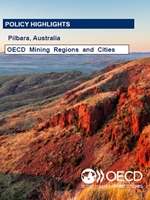Development

Mining Regions and Cities Case of the Pilbara, Australia
Located in the state of Western Australia, the Pilbara is a large region and one of
the least densely populated within the OECD. The Pilbara's mining sector is a top
supplier of iron ore in the world, which has fuelled the economic growth of both the
state and the country. While Pilbara’s industrialisation is relatively recent, dating
back to the 1960s, First Nations peoples have inhabited the region for approximately
50 000 years.
Despite the wealth generated by mining and extractive industries, the Pilbara faces
important challenges to improve its attractiveness and well-being standards, especially
for First Nations and non-mining workers. Well-being challenges also stifle growth
opportunities and responsible mining investments in the region.
The green transition presents the Pilbara with an opportunity to diversify its economy
and improve well-being conditions of its communities, while becoming a strategic player
in the global shift towards more sustainable mining. This study offers guidance on
how the Pilbara can shape a more inclusive and sustainable development model that
supports economic diversification and prioritises improving the living conditions
of its communities, particularly First Nations.
Available from October 10, 2023
In series:OECD Rural Studiesview more titles
TABLE OF CONTENTS
| Foreword | |
| Abbreviations and acronyms | |
| Executive summary | |
| Assessment and recommendations | |
| Strengths and challenges for regional development in the Pilbara | |
| Maximising the Pilbara’s potential for a sustainable and diversified economy | |
| Improving liveability in the Pilbara |
Powered by OECD iLibrary
